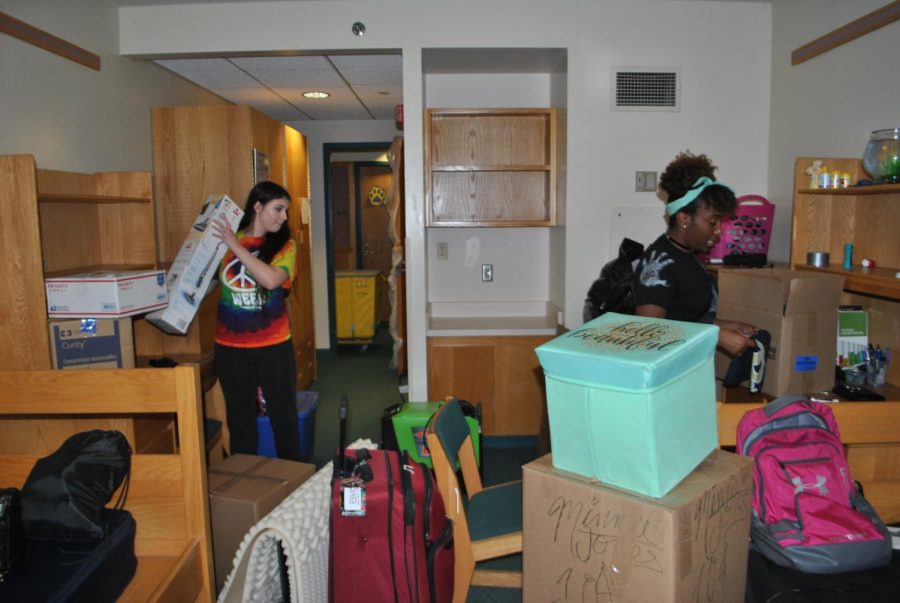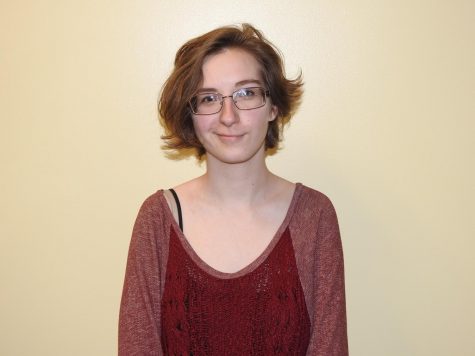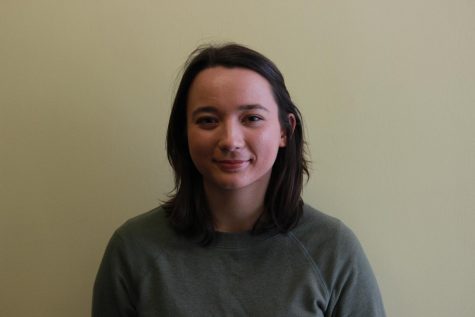Mold comeback anticipated 26 students get a relocation
Sophomores Brittney Cesari (left) and Minnie Jones (right) pack their belongings Oct. 7 out of their first-floor Living/Learning Center room.
October 10, 2018
-Correction-
A relocation article last week said that Servpro Restoration would begin cleaning the 16 affected Living/Learning Center rooms Sunday. The actual start date was to be Monday. The article also misattributed a Student Affairs Vice President Chris Stumpf qoute about air quality levels being safe, but elevated, to Housing Director Bob Knipple.
On Sunday, 26 Living/Learning Center residents were required to clear all of their belongings out of their 16 first-floor rooms due to a reported fear of a mold comeback, according to multiple emails Housing Director Bob Knipple and Student Affairs Vice President Chris Stumpf sent out Friday.
Students also were ordered to be out Sunday to reside in temporary rooms at the Quality Inn along Theatre Drive.
A misdirected email was sent to all center residents around noon Friday notifying them of a required relocation and of a question-and-answer session with Stumpf from noon to 4 p.m. Friday.
A revised email listing of only the 16 affected rooms was sent out half an hour later.
Relocated students lacking cars were able to move into lodges, first-year halls or Living/Learning Center rooms on other floors. Students were encouraged to leave most of their belongings in marked boxes in the center’s first floor Terrace Room, and only bring the week’s necessities to the temporary rooms, according to the emails.
Residents of affected rooms were to be compensated $100 in Mt. Cat Cash, which can be used at Sodexo food stops and the Student Union bookstore.
A Servpro Restoration thorough cleaning was to start Sunday after move-out finished, and was to continue for two to five days, the email said.
Mold was first spotted in center rooms Aug. 20, Stumpf said. Maintenance staff cleaned affected rooms before move-in, but it was spotted again less than two weeks into the semester.
Servpro cleaned all 200 center rooms Saturday, Sept. 8 through Tuesday, Sept. 11, Stumpf said.
Dehumidifiers were left in all rooms overnight, and some were removed—pending a humidity level of under 60 percent—Sept. 25.
Those with humidity levels above that were stuck with the noisy machines since their arrival.
Stumpf said students were not compensated for the several weeks with dehumidifiers in their rooms.
Stumpf said the air-quality readings in the 16 affected rooms were significantly above the average of the air-quality readings in the other rooms.
It was unclear what was being measured to determine air quality at an acceptable level.
“They’re safe (levels), but elevated. We’re going to double-clean them and make sure the levels drop down to the readings we want all the rooms to have,” Stumpf said.
Stumpf said he didn’t know the science behind the readings, but that Pitt-Oakland Environmental Health and Safety Department staff was monitoring test results and requiring room rechecks.
The Pitt-Oakland health and safety director, Jay Frerotte, did not return telephone calls Friday to discuss air quality.
The first time mold became an issue, administrators worked with Norac Laboratory of Johnstown, to test air and monitor results. A call to the lab, to see what involvement it still had in the issue, directed an Advocate reporter to Pitt-Johnstown Facilities Management Director Walt Kalista III, who did not respond to calls Friday.
Knipple said that the readings are still at safe levels, just that they were elevated.
“There are no health risks…The readings in those rooms simply indicate that conditions were favorable for mold, but no active mold was found. Students are safe remaining in those rooms until Sunday.
“We are relocating them so that we can go into those 16 rooms, conduct a thorough cleaning, and assess moisture levels. If, for example, there is moisture in the walls, we will do what is necessary to address that,” Knipple said.
Center resident Jimmy Sumerfield attended the question-and-answer session, even after learning that his room was not affected.
“We’re paying over a $1,000 a semester for a building that is not up to health and safety standards. I’m livid right now,” Sumerfield said.
Sumerfield called the relocation an invasion of privacy, and said that the money for food stops was an unsatisfactory compensation.
“I’m happy to be proven wrong, but, until then, I’m going to continue to be upset about it.”
Lacey Nye, whose room is one of the 16, was concerned about living at the motel because she doesn’t have a car.
Stumpf told Nye that only three or four rooms were totally open for a pair of roommates to move into, but that students without vehicles would have prority for campus emergency housing.
“We’re trying not to split (roommates),” Stumpf assured Nye.
Nick Begonia, who also lives in an affected room, said he felt the situation could easily have been avoided, but that he didn’t actually know.
President Jem Spectar gave a statement late Friday.
“I know the situation is disruptive to students and understand that it can be very frustrating; however, these precautions are necessary to ensure that there is no future recurrence of mold.
“I would add that I have been assured by the (Pitt-Oakland) Department of Health and Safety that the building is safe. The building is safe,” he repeated.
“We are deeply sorry for the inconvenience. I have asked my team to look at everything that we can do to minimize disruption. Staff will be available to help move belongings out of rooms to make it easier for students.”



